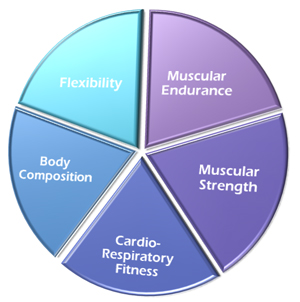In the pursuit of a healthy lifestyle, achieving overall fitness goes beyond just the physical aspect. It encompasses a holistic approach that involves various components contributing to one’s well-being. Understanding these components is crucial for crafting a balanced fitness regimen that promotes long-term health benefits. Let’s delve into the essential components of health fitness:
- Cardiorespiratory Endurance: Also known as aerobic fitness, cardiorespiratory endurance refers to the ability of the heart, lungs, and circulatory system to deliver oxygen to working muscles during prolonged physical activity. Activities such as running, swimming, cycling, and brisk walking improve cardiorespiratory endurance, enhancing overall stamina and reducing the risk of cardiovascular diseases.
- Muscular Strength: Muscular strength is the capacity of muscles to exert force against resistance. Resistance training, including weightlifting, bodyweight exercises, and resistance band workouts, helps build muscular strength, promoting better posture, joint stability, and bone health.
- Muscular Endurance: Unlike muscular strength, muscular endurance focuses on the ability of muscles to perform repetitive contractions over an extended period without fatigue. Activities like circuit training, high-repetition weightlifting, and calisthenics improve muscular endurance, enhancing stamina and reducing the likelihood of muscular fatigue during daily tasks or sports activities.
- Flexibility: Flexibility refers to the range of motion around a joint or a series of joints. Stretching exercises, yoga, and Pilates are effective in improving flexibility, enhancing muscle elasticity, joint mobility, and posture. Maintaining good flexibility reduces the risk of injuries and muscle stiffness, especially as one ages.
- Body Composition: Body composition relates to the proportion of fat, muscle, bone, and other tissues in the body. Achieving a healthy body composition involves maintaining an optimal balance between lean muscle mass and body fat percentage. A combination of regular exercise, balanced nutrition, and adequate hydration contributes to achieving and sustaining a healthy body composition, which is essential for overall health and physical performance.
- Balance: Balance is the ability to maintain stability and control over the body’s center of gravity. Balance training exercises, such as yoga poses, tai chi, and stability ball exercises, help improve proprioception and coordination, reducing the risk of falls and enhancing functional movements in daily activities.
- Coordination: Coordination involves the integration of sensory information and motor skills to execute smooth and efficient movements. Activities that challenge coordination, such as dancing, martial arts, and agility drills, improve neural connections and motor control, enhancing overall movement efficiency and athletic performance https://dailybamablog.com/.
- Mental and Emotional Well-being: Mental and emotional health plays a significant role in overall fitness. Engaging in stress-relieving activities like meditation, mindfulness, and relaxation techniques fosters emotional resilience, reduces anxiety and depression, and promotes better cognitive function. A positive mindset and emotional balance are vital components of holistic health and fitness.
In conclusion, health fitness encompasses a multidimensional approach that addresses various aspects of physical, mental, and emotional well-being. Incorporating activities targeting each component—cardiorespiratory endurance, muscular strength and endurance, flexibility, body composition, balance, coordination, and mental/emotional well-being—into your fitness routine can lead to a healthier, more vibrant life. Remember, achieving true fitness involves balance and consistency in nurturing all facets of your well-being.









